Pens! They just might be the cheapest, most important piece of technology ever overlooked by a large group of people on a daily basis. Pens are everywhere from your desk to your car to your junk drawer, though they tend to blink out of existence when you need one. Where would we be without them? Probably still drawing on cave walls with dandelions and beets.
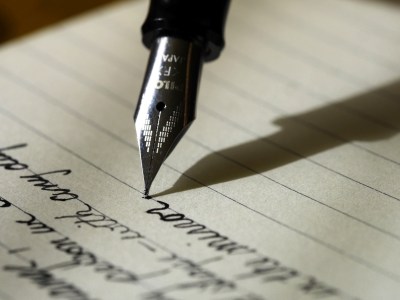
Why do I think pens are so great? Well, they’re a relatively cheap tool depending on the pen you get, but whatever you spend, you’re getting a lot for your money. Pens are possibility, pure and simple, and they’re even conveniently packaged in a portable device.
Aesthetically speaking, I like pens because of how different they can be both inside and out. Some of them make thick lines, some make thin lines, and in the case of flexible nibs, some alternate between thick and thin lines depending on pressure. I use pens for a number of reasons, most notably for writing. Everything you read here that bears my name began life as pen marks on paper.
Pens are revolutionary because they can be used to make ideas permanent and/or illustrate any concept. It’s up to you to use the pen wisely. You can use other, better tools later, but pens are always a great first tool. If you’re not encumbered by an uncomfortable grip, ink that skips, or a scratchy, draggy contact point, your ideas will flow more freely. When you find the right pen for you, you aren’t hindered by your tool — you’re elevated by it.
This Machine Kills Fascists
In Margaret Atwood’s terrifying sci-fi future of The Handmaid’s Tale, the only women who are allowed to read and write are the Aunts — high-ranking women who train Handmaids and dole out punishment to anyone who’s earned it, regardless of rank. All signage and packaging in the republic of Gilead has been reduced to ideograms to prevent Handmaids, Wives, and little girls from reading literally anything, ever — lest they be empowered to organize and change their fates. Get caught reading or writing in this hellscape, and you’ll lose a hand.
There is true freedom inherent in writing implements that most people take for granted. You are free to write anything you want, though you may want to burn it afterward. Sure, the freedom is all within the larger construct of humanity and what is humanly possible, but pens push us toward possibilities and into the future. Most importantly, pens help us think. They are works of art that produce works of art. I once found a pencil that bears Woody Guthrie’s proclamation ‘THIS MACHINE KILLS FASCISTS’. I wish it were a pen instead, because pencil marks can be easily erased by fascists.
Pens help us communicate ideas and explore our thoughts. They are a tool of total insight. Typing may be faster, but writing by hand gives us more time to form what we’re going to say as we go along. It’s much easier to haul around a pen and paper everywhere you go than to lug a laptop or typewriter. As long as you have ink and a substrate, you’re good to capture any thought or idea, no batteries required. Now that’s freedom.
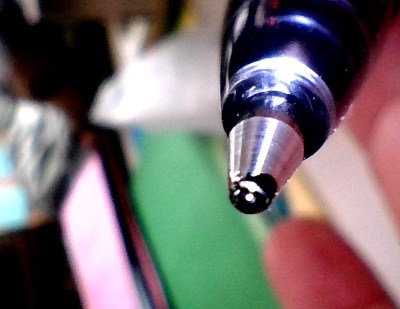
Pen Psychology
If I ever feel stuck or out of ideas, sometimes all I have to do is change my pen. I also change pens when I need a fresh mindset, or if I want to color-code something.
Until recently, I would change my pen color just about every day, but a few months ago I got stuck on this one 0.7 mm black Pilot G-2. For some reason, I just got into the flow of that one pen even though they always get blobby on the tip, and there’s no point in fighting against something that’s getting me to a flow state.
I wanted to try the bold ones (1.0 mm) and I did, and now those are officially my jam until further notice. I’m sure I’ll go back to using a rainbow of pens at some point, or at least get bold G-2s in more colors.
Gels Are Swell
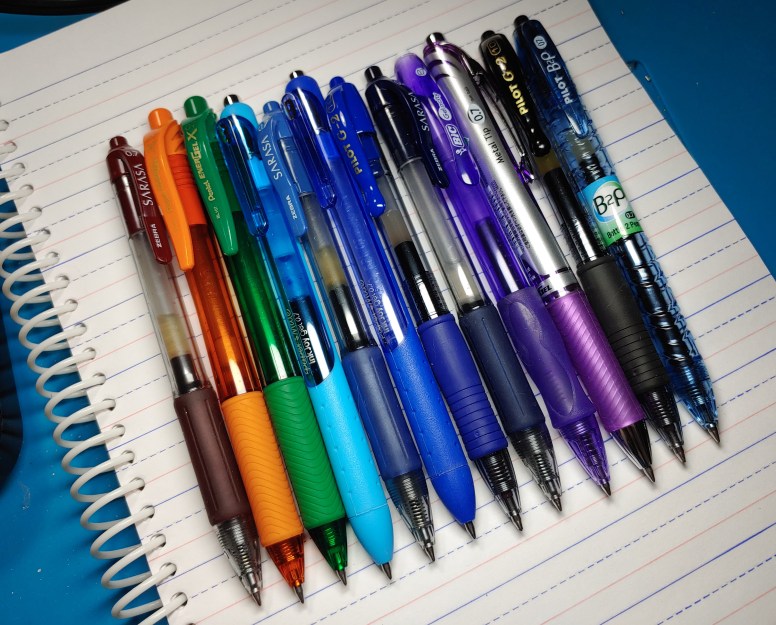
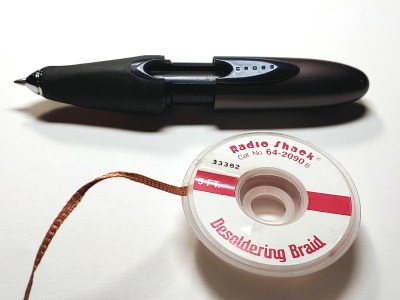
I’d have to say that gel pens are my hands-down favorite pen as far as everyday use. Gel pens came about in the mid-1980s and hit the United States in the late 1980s, and I remember them supplanting rollerball pens as the hottest thing out there among the young pen nerds. Anyone who was anyone at my elementary school had Pilot Precise Rolling Ball pens in four colors, but only the super cool kids had Gelly Roll pens.
I have a tendency to tense up and press way too hard when I write, and this comes from learning to write with pencils and ballpoints. The dark and free-flowing, easygoing marks made by gels help me to back off so I can write for much longer periods of time without fatigue.
I like gels because for the most part, they’re always ready to write and they don’t get all faint and skip-prone like ballpoints do. I go through phases where I’ll use a rollerball or a fountain pen for a while, but I always come back to gels. They’re easy to carry around, especially the pocket Cross pen I’ve had for about twenty years now. Isn’t it cute? You just pull it apart to open it, twist to change the cartridge, and push it back together to close it.
Fountains of Fun
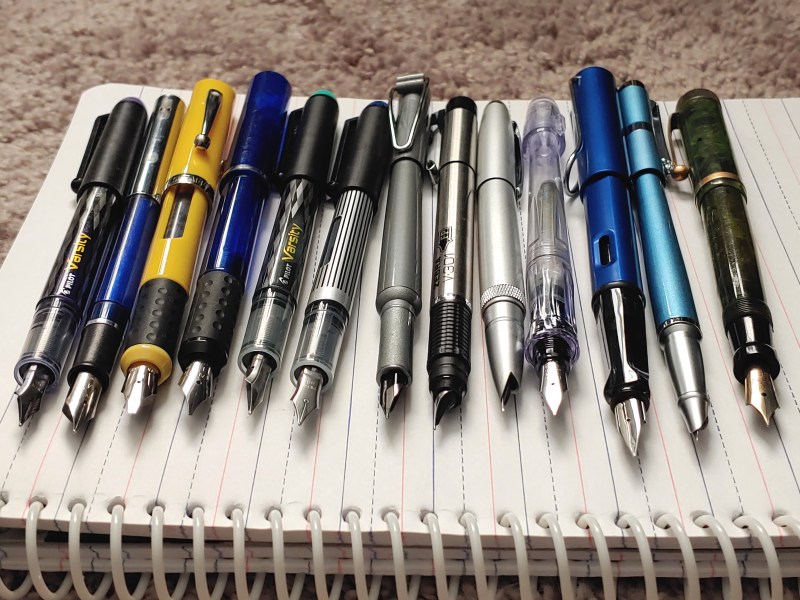
I really like to use fountain pens, even though I have to write more slowly with them. I’ll go in and out of using one of my fountains exclusively until I get tired of uncapping and recapping it all day long, and then I go back to gels. There are several retractable fountain pens out there, but they’re all quite expensive ($80+).
For the most part, I prefer the cheap and mid-range fountains to the expensive ones, but I’ve only had one expensive one so far and I didn’t like it: the Lamy Safari. I think the problem was that I didn’t bring my own paper to the fancy pen store, which I would now recommend to anyone. They have paper, sure, but it’s always fancy paper and not everyday paper like you find in a spiral, legal pad, or composition book. Also, see if they’ll let you sit down to try the pens instead of hunching over the glass case, because sitting versus standing makes a difference, too.
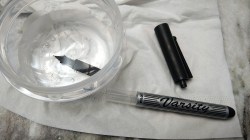 There is a line of disposable fountain pens called the Pilot Varsity that I’ve used for around twenty years. They’re disposable in the sense that you can’t easily refill ’em, unless you’re dedicated and savvy and willing to get a little bit inky at some point. I’ve done it myself using this method, and it was surprisingly easy to both remove and re-seat the nib using a pair of nylon jewelry pliers.
There is a line of disposable fountain pens called the Pilot Varsity that I’ve used for around twenty years. They’re disposable in the sense that you can’t easily refill ’em, unless you’re dedicated and savvy and willing to get a little bit inky at some point. I’ve done it myself using this method, and it was surprisingly easy to both remove and re-seat the nib using a pair of nylon jewelry pliers.
Varsities are great for everyday use, except they’re a little scary to carry around. If it gets uncapped and encounters anything that can wick the ink out, that’s gonna be a bad time. But they hold a ton of ink and pretty much always work right away even if I haven’t touched them in months or even years. Really.
Fancy Pens for Fancy Letters
I have long been attracted to typography and calligraphy and sometimes mess around with both, so I have all kinds of calligraphy markers, nib holders, nibs, and brush markers.
Among the weirder ones are a couple of dip pens that are just cleverly-carved sticks of bamboo. I also have two pencils taped side-by-side that produce calligraphic letters when held at a 45° angle. I’ve even got this pen I made that looks like a little prison shiv made out of a piece of Sprite can that’s taped to a never-sharpened pencil. And fright is kind of the point — you just dip it in ink and it holds a few words worth of drippy, slasher film-type letters. I got a lovely glass pen for my anniversary this year. It’s a dip pen, but the spiral ink feeder holds more ink than you’d think.
My Beef with Ballpoints
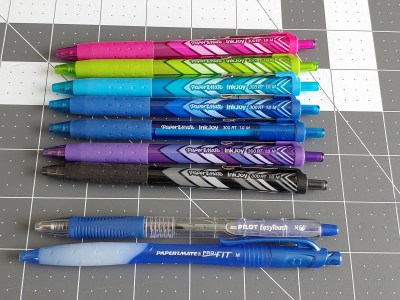
I straight-up don’t like ballpoints. Okay, that’s not fair. I like ballpoints quite a lot in theory — their viscous, oil-based ink doesn’t get used up as quickly as gel inks or water-based inks, they can make beautiful artwork, and above all they represent the era when ink-powered writing implements became cheap and portable. But they’re just not for me.
I wish I liked iconic, ubiquitous, everyday ballpoint pens like the Bic Cristal or the lowly Round Stic. I press pretty hard when I write even though I try not to, and ballpoints usually make me press even harder which makes my hand and wrist ache sooner. I can’t and I won’t use ballpoints for the most part, unless they are really smooth to use and make a dark mark.
I do like Paper♥Mate InkJoys and wish other ballpoint makers strove to make theirs as bold and smooth. And once in a while, I’ll find a promotional pen that writes really nicely for some reason. Those are ballpoints 99% of the time, and nearly always have black ink. I wish I liked ballpoints so that I could enjoy using one or more of my collection of four-color pens from decades past. I have the 4-color InkJoy and the output is really disappointing compared to regular single-color InkJoys.
Thinking with Ink
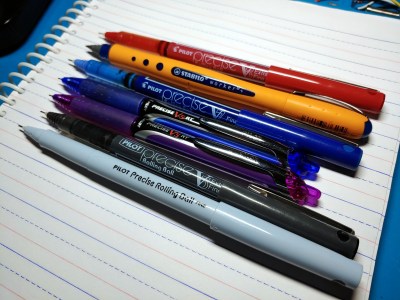
I really enjoy the act of writing longhand, and using the right kind of pen can make a huge difference in my output and flow of ideas. A good, comfortable pen is a great way to get going and start flowing no matter what you want to do, especially if you need to get a bunch of thoughts in order first. What are some of your favorite implements for capturing and fleshing out your ideas? Let us know in the comments!


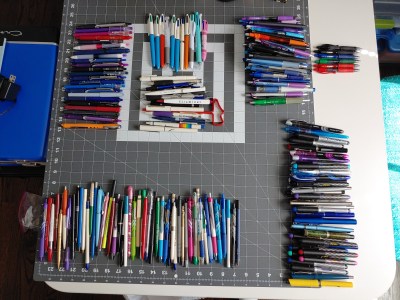
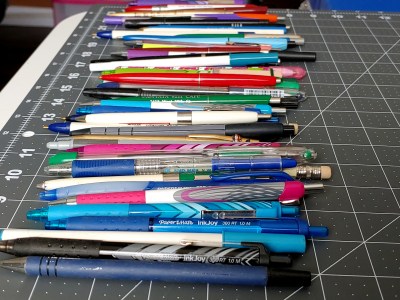
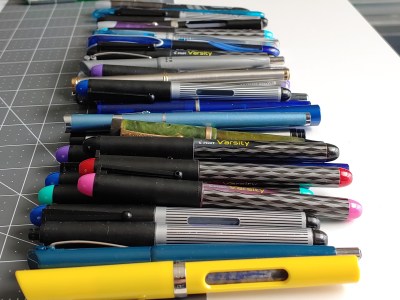
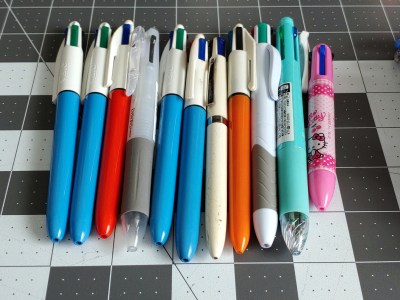
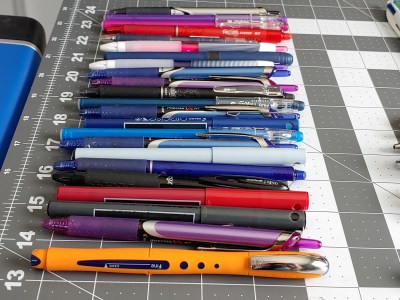

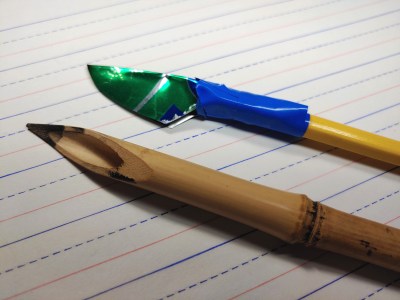
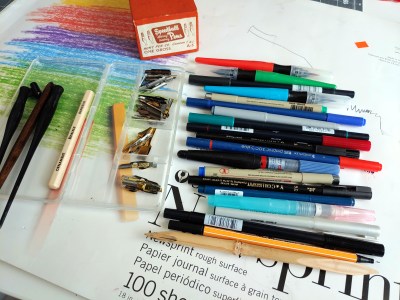
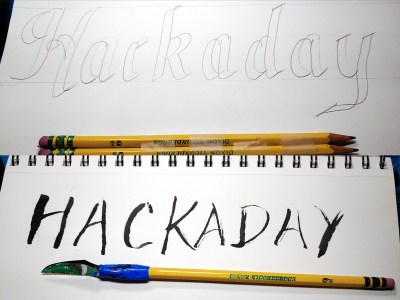
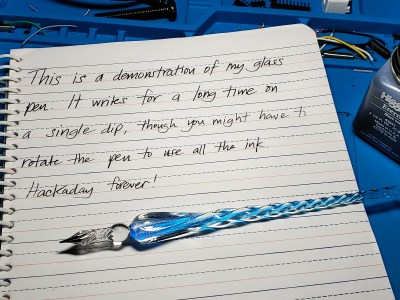














I just bought a set of used Rotring Isograph and Micronorm pens off fleabay. I used to use these as a student, being left-handed they were better at keeping my hand off the still-drying ink, and also made my spidery handwriting look almost presentable. They also satisfied the school requirements of being a fountain pen. No biros allowed back then!
After a few hours yucky cleaning out, 14 were working and one has a busted nib (the wire has separated from the weight) so quite a baaargin. So I have a set ranging from 1.0mm down to 0.13mm diameter.
0.25mm used to be my favourite but these days I think 0.3 or 0.35mm are more comfortable especially on cheap paper.
I’m going to have to try a Rotring or two!
I do like the feel of Rotrings; I used to use a couple of Isographs for technical drawings (I think a 0.5mm and a 0.18mm – the latter prone to bending or breaking as the nib was quite delicate). Once you work out the right angle to hold the pen, they would give perfectly precise lines but the finer nibs were certainly more liable to get ‘scratchy’ if you got too shallow.
Alas I don’t know where they are or if they still work as I’ve not had any need for them and only recently got back into trying to do better technical drawing for my hobby projects with a more meagre Rotring Tikky that I’m quite liking.
It will cure your problem of pressing too hard! Press on them and you’ll bend the nib and ruin it.
Classic Rotring with a Fisher Space Pen cartridge. QED.
That’s not a Lamy Safari! It’s a Lamy Al-Star. (The only difference is that the Safari is made of ABS and the Al-Star is aluminum.)
I won’t make too much fun of the idea though that an “expensive” fountain pen is a $30 one… The Safari, Pilot Metropolitan, a number of TWSBI pens, at $20-$30, they’re about as cheap as you can get without being disposable. My personal love is the Lamy 2000, which are mid-priced pens and can be found (sometimes) at $120. And then, of course, you can spend as much money as you have if you want the fancy Namiki “hand decorate with urushi lacquer and gold dust by artisans” models.
The cost does make it a little tricky to buy one if you don’t have a store nearby. I’m pretty convinced though that they are the superior writing experience. I know it’s far easier for me to write out my pages and pages of lecture notes with a good fountain pen than it is to do the same thing with anything else.
I paid around $60 for whatever type of Lamy that is. Did I get ripped off?
That’s a lot to pay for an AL-Star, unless there’s something special about it.
My personal favorite is the Lamy Safari, with a 1.5 mm Calligraphy nib. I have a bunch of other nibs which I swap in and out, but that one is the one I keep coming back to.
It’s all dependent on a mix of personal taste and variation. How you hold the pen, how much pressure you use, what angle you make between the pen and the page, how fast you write, what size your letters are; all this and more will affect how well you get on with a pen and the nib.
I love a gel ink pen too. I didn’t used to; but in the past 10 years or so they do seem to have improved a lot, and for fast note-taking I love a Bic Gelocity, despite the atrocious name.
If you paid $60 for a Lamy Al-Star, then yes.
To get better performance on your paper, try a Fine or Extra-Fine nib and drier ink. You can add water to ink you already have to make it drier — this dilutes the lubricant and/or surfactant — go very slow on adding.
I paid a more than $30 for my TWSBI 580AL, I am very fond of its extra fine tip.
Only on Hackaday, will you find a roll of desoldering braid used to show scale for an ink pen :)
But it worked! Are there different sizes of desoldering braid? That one looks about the same as the ones I have.
Grainger lists at least 3 different sizes.
For a good experience with hooded fountain pens, I recommend the Hero brand (like the Hero 616). They are incredibly inexpensive and very smooth. For a normal nib I recommend the house brand from the Noodler’s Ink company (and their inks, too). They, also, are very economical as are their inks which are also very good and have many specifiable characteristics.
Koh-I-Noor Rapidograph 4×0 point (0.18 mm) “technical pens” and India ink to jam as many microscopic formulas and solution methods onto the single allowed 3″ x 5″ card for exams. By the time all the scribe-work was done, you’d remember it anyway.
Brave souls would try the 6×0 (0.13 mm) point but they clogged far too easily for we mere mortals.
Agreed. I treasured my Rapidograph 7-pack. It was not cheap, but it was worth every penny. I used them for college homework, drafting, and even letters home. The goal was to pack as many words and cartoons on the piece of paper as possible. The end result was usually finished with colored pencils. They were way too fiddly and required constant cleaning, but they were awesome.
Speak for yourself, [Anonymous]. I come here to learn about tools and techniques. Pens qualify. Don’t like it? Then don’t waste your time commenting — just click on to the next article or blog.
Sounds like you missed the shiv pen. Hmph.
Hello Pauline.
😃 Pens are indeed friends.
Get a grip Mickey!
Good Morning Job seekers..
(Filling in the 99.9% of the population here, BBC League of Gentlemen)
What is your definition of “hack”. I think the article laid it out clearly. You do not have privacy keeping notes on your computer, tablet or phone. The internet is a surveillance dystopia. Hack the system, stick to the fascist and use a pen.
I’ve never seen anyone argue that using pens and paper is punk. I like it.
When I bought my first car, I grabbed a random pen off someone’s desk to use for the paperwork and mindlessly shoved it in my pocket afterwards. I didn’t realize until much later is was a Mont Blanc pen worth over $150. Seeing has how the dealership ripped me off, I didn’t feel to bad about keeping it. 20 year later, I still have it on my desk and use it for signing important papers and documents. Surprisingly, it doesn’t write very well.
Those kind of fountain pens only keep working properly if you use them daily. I have the same problem with a $100 Sailor pen…
That’s not been my experience. If the cap has a good seal it can work even after months of being idle. But this is not the case for every pen. Price is less relevant than the design of the pen.
I think that Mont Blanc is really more about the branding than the functionality. There are a ton of pens at their price point and lower that write far better. There’s always a possibility too that the nib might be out of alignment… especially if you grabbed it without realizing it was a fountain pen. There are plenty of folks who will tune it up for you though.
Considering that you found it at a car dealership, I would speculate that there is a much higher than average chance of it being a fake or replica.
Fisher Space Pen-the bullet pen in maroon lacquer with a black fine point, fit in my pocket, always at hand. Writes _on_ my hand for task reminders that are constantly in view. Writes on a paper scrap held on the nearest flat surface-generally a wall or a door. No blobs. No skips. Precision lines for drawing or writing. I lost it before it ever ran out of ink. Before that, I had the backpacker size-tiny, but again, pocket size. I managed to crush one, and lose another. So this time I replaces it with the Trekker. Hangs on a lanyard next to my work badge. I have high hopes….
In college, my favorite writing instrument was a Staedtler-Mars 0.5 mm mechanical pencil. Lovely to write with, but you can’t sign official forms in pencil….
Was going to mention this.
Works great – fabulous design – writes on wet paper – writes over grease.
Part of my EDC clipped into my pocket right next to my Kershaw Cryo.
How do you get no blobs? I tried carrying a Fisher Space Pen in my pocket and the first time using it every day or after any length of time in a pocket and it had a giant glob. Tried new refills…same problem. Now it’s in a desk drawer.
I don’t get that with the Bullet I carry (just checked the tip and it’s fine). It could be that the Bullet when closed and clipped into your pocket has the point riding at the top as opposed to some of the other more conventional extend/retract full sized designs where you end up carrying it tip down?
this also is about as much as i know about pens: it writes on my hand without clogging or getting dodgy! :) i like fisher space pens and parker jotters for this reason. other than that, i would just use disposables
Pour one out for my beloved but discontinued 0.18mm Signo Bit. Loved those pens.
I imagine as a bunch of geeks we could modify a picosecond laser pen to write with.
https://www.amazon.com/Cleared-Newest-Professional-Picosecond-Laser/dp/B082XYMN74/
I’m not quite in the same place as the author regarding pens, but I *did* embark on a bit of a quest to find the pen that was right for me. Disposables weren’t quite my jam. I tried a cheap fountain pen once, and while I see the appeal, they’re not quite what I was looking for. Eventually I worked my way around–or back to–Fisher Space Pens. I tried the Bullet first. It’s a great pen to write with and feels good in the hand, but I found it inconvenient to pull out for small writing tasks like signing something. I’m currently using the Fisher M4 Capomatic in matte black. It’s not quite as nice in the hand for writing as the Bullet, but I can pull it out of my shirt pocket, click it, write, click it, and put it back all with one hand. Also, it’s all metal.
uni-ball signo 307 at 1.14 bucks per pen, has gel, has smooth writing
why pay more when i can get a japanese made quality pen by mitsubishi
I love writing with a fountain pen, although I hate having smurf hands, they really change the whole flow of your handwriting. And as for thinking, when writing out the chalkboard I say every letter in my head before I write it, it not only makes the writing better but it makes you really think about what you’re writing.
I’m guessing ‘smurf hands’ means you turn your hands blue when you use a fountain pen? Does that mean you’re a lefty? Or do you have a very unorthodox right handed pen grip?
I am guessing you dont interact with ink bottles frequently :)
I do, I use fountain pens and some other types of refillable pens. I usually have a little tissue paper to dab away any excess after a refill, but other than that the ink goes where it should.
The most trouble from fountain pens I’ve ever experienced would have been in my primary school when some of the boys discovered they could flick ink from their fountain pens. I struggle to lay the blame wholly on the tool in that case though.
At least they couldn’t dip your braids in their inkwell any more.
Well I always had some ink on my fingers after a clean and fill. My comment was just for pointing to that possibility.
I got acquainted with fountain pens (ball-nibbed) in my teenage years, and they certainly changed the flow of my handwriting. As a lefty, to avoid smudging what I’d just written, I developed a strong overhook and rightward slant in my writing.
I’ve still got a fountain pen that I use now and again (a silver Paker Latitude). I enjoy the fact that I can blend inks to get a slightly different hue – blue with a hint of green – it’s hard to do that with a ballpoint.
However, as a daily driver, I’ve got a small stock of Bic 4 Colour ballpoint multipens: they’re useful when scribbling down a circuit diagram (with good use of colour) or marking students’ work, but not so valuable that I need to start panicking about which desk I just left it on.
Rotring pens apart from the artpen are horrible. Leaking, drying up etc.
Probably spent more time cleaning, soaking them than using them.
As a lefty in grammar school, I received no penmanship lessons, as the teacher was too lazy to figure out how to teach to left-handed students. My experience with pens is that they get ink on your hand. Thank goodness for computers and the two fewer steps to first base.
Hehe, I’m so used to “first base” being a euphemism in American that I forgot it has a meaning where handedness is important.
jMy thought as well — and I’m even a bit of a baseball fan! Funny where the mind goes sometimes…
The Cross Pen was the last pen I had until I stopped needing to write daily.
Haven’t seen even a picture of it since then; had a feeling like the guy from Ratatouille haha
You can still get them from the Bezos Barn and the electronic bay!
Honestly, hacks are boring. I love tech, but hacks mostly suck and are about the least interesting part of a techie’s life, and I don’t even know why programmers like them, although they can be cool as novelties I suppose.
If a lot of tech people like pens, that makes the pens a part of our shared culture, and just as interesting as hacks.
And this is coming from someone who hates handwriting and paper documents and often goes weeks without touching a pen or pencil.
As a lefty pen smearing has always been an issue for me, I tended to use mechanical pencils up through college because left handed underwriting worked so poorly with cheap ballpoints. I never considered trying a fountain pen until I watched a franlab video about them.
I got a safari and it turned out great, $20 seemed expensive but I had already invested more than that in good mechanical pencils that have lasted 6+ years.
Underwriting is even more mandatory than with ballpoint but almost no contact pressure is required to make clean consistent lines. In the end I also got a couple of extremely cheap chinese pens, both shanzhai and local brands. My favorite daily driver for several years now has been a short brandless, extremely heavy brass pen that cost maybe $2 on alibaba.
If you ever get stuck for something completely different I suggest trying a yookers. Felt like tip. Uses fountain cartridges. Different tip sizes. They have a unique feel. I am on my third cartridge with a 1.4 tip. Rarely do I not switch to something else when I go to refill.
Thanks for mentioning “multis”,
I like the convenience of having multiple colors in one writing instument.
(back in college a class mate and I each used a 12 color pen for making lab and class notes)
But, as much as I like Bic 4-Color pens, I’ve thrown 3 away this past week, the ink dried after a few years, and I was unable to get them to flow with heat, or alcohol soaks.
Similar experience here, these days my go to is an Ohto MF-20K3B through. 2 pens + 0.5mm pencil and a rubber under the button. Standard inks are pretty average imo, but it’s a standard refill so you can swap around to whatever suits you.
Cool mechanism too, the orientation you hold it in when you press the button selects the colour.
The “Pilot Something or Other” is a Pilot Penmanship Pen if anyone is interested.
https://www.jetpens.com/Pilot-Penmanship-Fountain-Pen-Non-Color-Extra-Fine-Nib/pd/4008
If ever I were to try a fountain pen again (been decades) I’d go with Pilot. As a university instructor or prof for 42 years I did a great deal of handwriting, and every pen I have ever truly loved has been made by Pilot. My writing—printing, actually, I gave up cursive around age 14—is small. I prefer narrow-rule looseleaf to the more common college-rule. So I wanted a very fine-tipped pen that could stand being lifted up from and pressed back down on the paper literally hundreds of thousands of times, without smearing. And Pilot always did that best. Currently the G-2 0.38mm leads the pack.
I picked up my first G2 overseas and began sending email to Pilot to have them bring it to the U.S.
I was shocked when they actually did. Current favorite it the Ohto Rays, but I only print and I use pencils more than pens. I think pencils have accelerated the advance of mankind…
Thank you! *wastes another 20 minutes on JetPens*
For me, the best designs start out with a mechanical pencil, 0.5mm hb or softer lead and square grid paper.
Good article!
If I mention waving a butane lighter under the tip of a spotty writing ball point (a Bic lighter under the Bic pen) Will that make this article qualify as having a hack factor.
Someone above mentioned capping pens to prevent drying.
I hope that means that not all of them come with a hole in the small end now!
I’m told it’s for choking hazard. But danged if the pens don’t seem to go dry fast now.
A dab of glue in the hole didn’t seem to much difference, so more likely that the magic chemicals in the ink were declared unsafe in California.
Great artwork Joe!
Who’s Joe? :)
Joe Kim, HackADay’s art director.
My comment was in regard to the Title Image.
Agreed! I’d love to see an extended version
Pens kill fascists? I interesting, because actual fascists are extremely rare. I used to know one about 30 years ago…
The pen is mightier than the sword.
We hear about them daily, they must be everywhere…
Rude and completely out of line.
Remember Outliners? They would write in silver with a thin orange, purple or whatever line at the edge. I can’t seem to find these any more.
I spent a solid hour in the pen aisle recently and settled on a Uniball Jetstream 1.0 that writes in red and bought ten of them. Hopefully they’ll outlast me and I won’t have to spend that hour again.
Try a Pentel Hybrid Dual Metallic. Awesome for greeting cards.
Sakura Gelly Roll pens have a series called Silver Shadow and Gold Shadow that have very similar sounding characteristics to what you were describing.
https://www.jetpens.com/Sakura-Gelly-Roll-Silver-Shadow-Gel-Pen-1.0-mm-5-Color-Set/pd/2207
My favorite is the Cross Classic Century ballpoint, available in several colors and finishes. It’s slim, solid, and always smooth-writing.
I despise the cheap disposable plastic ballpoints, because the ball jams so frequently. I don’t care how cheap it is, if it doesn’t write reliably when I pick it up, it is no bargain.
There is one ballpoint every should try (in whatever barrel): Schmidt EasyFlow 9000, formerly in medium and broad, now only in medium. It’s way better than the average ballpoint and surpasses gels when writing on newsprint and other rougher, more absorbent paper.
I agree. this distraction from the norm might have been ok if it was a bit more terse…. plus everybody knows that pencils are better.
Is this *checks name* Dave from Reddit?
@Anonymous said: “Look, I get it, I like pens too… But this is not a hack.”
Here’s your pen “hack”:
A. Buy a Pilot Custom Heritage 743 fountain pen with an FA flexible nib, $268.95 USD on Amazon.[1] This a premium pen made in Japan, but the real star is the specially cut flexible (some say semi-flex) 14K gold nib. The Amazon price includes free ConUS shipping. The pen in the Amazon link is already shipped from Japan and imported into the U.S.
B. The problem with the Pilot 743/FA fountain pen straight from the factory is that it comes with an injection molded plastic feed. The plastic feed can not supply ink to the FA nib fast enough when it is being flexed, so the ink-starved nib railroads and skips. Not good.
The solution is to replace the factory plastic feed with a machined after market feed made of Ebonite, a form of hard rubber. Ebonite is hydrophilic and will supply much more ink to the nib compared to the plastic feed. The fact that an after market Ebonite feed is available for the Pilot 743 is not well known. You can get the $27.00 Ebonite feed from Mr. Joey Grasty at the Flexible Nib Factory LLC in Texas.[2] See the link at [3] for my tutorial in how to swap the feed in the Pilot 743. It’s not too difficult, but some instructions will help you succeed. Be careful hacking the feed, you will void Pilot’s warranty.
C. It is not part of the feed hack, but for the best performance I recommend you use Pilot or Namiki (Pilot sub-brand) ink in the Pilot 743. I am very experienced with fountain pens and fountain pen ink, both vintage and modern. I consider Pilot/Namiki blue ink to be the finest all purpose fountain pen ink made. A lovely 60 ml bottle of Namiki Blue ink will set you back $12.00 on Amazon.[4]
So that’s it. For $307.95 and a bit of hacking on the feed you have an heirloom quality modern Japanese manufactured fountain pen with a well behaved flexible nib that rivals many vintage flexible nib pens.
1. https://www.amazon.com/PILOT-CUSTOM-743-Black-nib/dp/B001AXB8ZM
2. https://flexiblenib.com/store/product-category/feed/
3. http://www.fountainpennetwork.com/forum/topic/339120-my-pilot-743fa-with-the-flexible-nib-factory-ebonite-feed/
4. https://www.amazon.com/Pilot-Namiki-Standard-Fountain-69201/dp/B005WPTYAA
This review is quite silly. The whole point of using different pens is to customize your experience. Fountain pens allow you to adjust the ink significantly compared to the other options available. Also, the Lamy isn’t an expensive pen. Getting into higher end pens is not cheap, but the quality of workmanship can be worth it depending upon the number of hours a day you spend writing. Just like a carpenter uses his tools, so do writers. If you’re looking for a high end pen to consider, look at the Pilot custom heritage 823, Sailor Progear, Pelikan m800, Lamy 2000, Mont Blanc 149, or a Nakaya. Each have their differences and are fountain pens. When it comes to ballpoints and roller balls and gel pens, all you need to do is focus on the cartridge. Consider a machined pen for using that cartridge if you want a heavier pen, more elegant experience, or a little customization. Choosing a pen can be a personal experience which is specific for each individual. There’s no right or wrong answer, using what you prefer is the only true choice. If saving money is your goal; sure, use that pen from the bank until it’s dry. But, maybe ask yourself while you’re writing next time, “Do you really love the pen your using right now?” There’s so many options out there, an article like this only scratched the surface on what’s available.
Pens are just something you use, you settle on something and stick with it.
I use pens for scribbling notes, very personal and informal.
The first big purchase I ever got was an electric typewriter, about 1975. I was fifteen, and I’ve never used a pen for anything external since then. My third computer, in 1984, was the first that coukd be used for practical purposes, which was writing.
There is no joy of penmanship.
You guys sound like the American Psyco comparing business cards.
Carry on.
I would, but I have to return some video tapes.
Careful criticizing the humble ballpoint, the writing tool of the common man, or you might find yourself labelled a pen fascist!
Good read. For years I have use the Rotring 600 ballpoint and really like it. I’d highly recommended checking it out with a more modern ballpoint style ink, it may win you over!
https://unsharpen.com/pen/rotring-600-ballpoint/
By the way, the Pilot Something or Other is called a “Penmanship”. On that note, I’m surprised you don’t like the Lamy Al-Star/Safari. It’s one of the classics and one of my favorites. It’s one of those pens that makes people like pens!
Yes, all the Rotring 600 are excellent and look like an engineer’s pen. But there’s a catch, they’re heavy on the hand.
Currently carrying the RapidPro… 2mm pencil and ballpoint. The 600 fountain pen is also very good (and very heavy, probably a weapon in some countries), the only minus is the hard to find nibs.
Hmm, has someone been watching Q:Into the Storm?
No, what is that? I don’t turn on the TV much.
Documentary running on HBO investigating who might be behind the Qanon phenomenon. Jim Watkins, the owner of 8chan which is apparently the “home image board” for Qanon, is a pretty heavy fountain pen nerd.
Wow! Someone who has (a few) more pens than I do!
If I click “report comment” and claim that this article is porn I wouldn’t be wrong.
Welcome to PenHub!
What, no replace it with a 555 timer comment?
It can be used to draw a 555 block diagram or circuit.
“Pens are revolutionary because they can be used to make ideas permanent and/or illustrate any concept.”
This is an important point (no pun) that applies to both amateur and professional STEM peoples. Lab notebooks and engineering notebooks, and the manually-entered test data forms that are still required by some NRTLs and notified bodies, all require much manual writing.
“Typing may be faster, but writing by hand gives us more time to form what we’re going to say as we go along”
I dunno, hand-written stuff cannot keep up with my brain. When code, prose, and correspondence are done manually, the slow entry causes much thought leakage. Hand-drawn schematics do, however, tend to be both more thoughtful and quicker than KiCad or Altium or Eagle or whatever.
My typical hand-written stuff is my logbook system made of Pentel pencils and Pilot gel pens and dozens of the $0.50 walmart composition books (both college-ruled and graph-ruled). The first two to four pages are reserved for an index. A notebook for each client project where left page can be diagrams, flows, calculations in pencil or pen; and right facing page are ‘final’ entry in ink only. Some notebooks for wiring and circuit design ideas – most entries in pencil, so not useful for any legal purpose. Notebooks for mapping of equations into algorithms; same left/right facing page configuration of pencil/ink. And the two notebooks kept in my truck and desk for general observations, ideas, and nefarious plots that are not applicable elsewhere – mostly ink.
I’m on team pencil, Uni Kuru Togas..they automatically rotate the lead as you write.
I got one of the Uni Kuru Togas as a leaving gift and it is now one of my go-to pencils. The rotring mechanical pencils are there as well. So hefty!
I’m so glad that this article exists. Kudos! I feel all warm to see all the stationary nerds massive stationary nerd :)
I keep saying to people that keeping physical notes is valuable for recall and consideration. Depending on what it is I tend to use pens to draw diagrams as you really have to think about what you’re doing as erasing things is much more problematic.
There is a bit scism in woodworking as well as some people argue that a fine tipped pen is better for marking up wood rather than a marking knife. Again, it depends on what I’m doing but I’ll switch between marking knife, pen and pencil to mark things up depending on what needs doing.
I have a saying to defend my love of paper and pencil: “Pencil and paper usually survives one trip through the washing machine. Your phone won’t.”
I like how you get get red/blue lead for mechanical pencils now. As an artist, I like to do the rough sketch in red and then blacken it later to once I know where the final lines are to be.
Whenever someone makes a joke about me writing notes with a pen in a pad, I chuck them on the ground and say “would your phone survive that?” No battery to go flat either! Bic 4 colour BTW. Colour choice is especially handy for circuit diagrams, but the tightwad in me gets cross when all the black and red gets used up and there’s still loads of blue and green in there.
My favorite pen by far is a Pilot G2 0.38, but I wanted more colors, so I found the Pilot Juice Gel line. They’re very similar to a G2 with a different grip, but they have a whole rainbow of bright colors in 0.38! I think they’re sort of a Japanese import, but they’re available online for a reasonable price.
Pilot G-2 0.38s were definitely my jam for a while!
I lived in Peru for a while and while I was there my work required me to always have a pen on me in order to make appointments or collect contact information (we didn’t carry laptops or smartphones for safety reasons). I was outside a lot and it was not infrequent to drop a pen in the dirt or on a concrete floor. It was a real struggle until I found a line of pilot ballpoint pens (I forget what they were called) that were the best pens I’ve ever used. I got back to the states ready to buy a lifetime supply and it turns out they are unavailable here. I was able to use the two or three that I brought with me until they eventually died, and now I am missing my perfect pens.
I found that anti-antiperspirants sold in Thailand much more effective than any I’ve bought in the U.S.
Doh! Otto Carrot added the extra “anti”
Great reading! Every time I got stuck thinking I start doodling around („kritzeln“) – that always helps a lot sorting my thoughts.